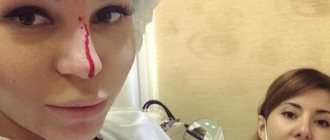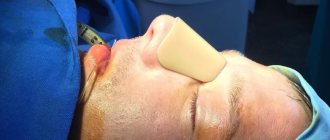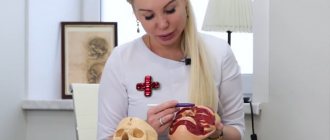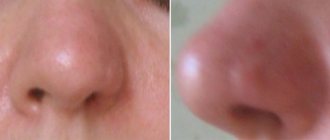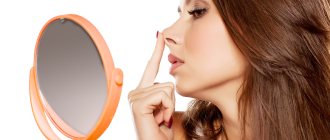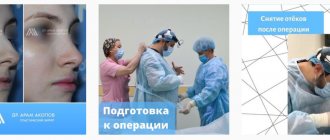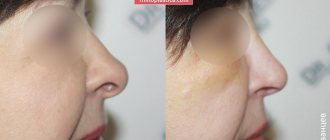Consultation with plastic surgeons with over 20 years of experience is free! Make an appointment by phone. Waiting for you! Non-surgical rhinoplasty is a minimally invasive method of nose correction using fillers and threads. The procedure is suitable for those patients who have minor nasal defects or are simply not yet ready for major surgery.
The non-surgical correction technique has both advantages and disadvantages that you should know about before deciding to undergo non-surgical rhinoplasty.
Non-surgical rhinoplasty with fillers is indicated for the following defects:
- Holes and ruts;
- Post-traumatic “dips” on the bridge of the nose;
- Nasal asymmetry;
- Small hump;
- Flattened (Asian) nose;
- "Eagle" tip of the nose;
- Excessively upturned tip of the nose;
- A large depression in the bridge of the nose, visible in profile;
- Postoperative defects (complications of plastic or otolaryngological surgery).
Non-surgical rhinoplasty often helps predict the effect of a full-fledged surgical intervention that the patient plans in the future.
Photos before and after the procedure performed by specialists at our clinic:
It is important to understand that during non-surgical rhinoplasty the nose will not shrink, but will increase in volume. Therefore, patients with a large, massive or naturally wide nose should carefully consider and weigh the decision to undergo the procedure. For such patients, there are alternative non-surgical correction methods.
How is nostril reduction surgery performed?
First stage.
First, the surgeon makes two wedge-shaped incisions on the sides at the base of the wings. The shape and depth of the cut determines how the final result will look. Therefore, there are several types of plastic surgery :
Type I – reduction in the thickness and length of the wings of the nose without changing the size of the internal cavity
II – view. The cut affects not only the base, but also a small part of the bottom. As a result, the nostrils appear more closed.
III – view. Significant reduction due to the removal of a large area inside.
Second phase.
Then the excess tissue is removed from each side . To do this accurately, the doctor must make markings using a special ruler before surgery. The exact amount of tissue to be trimmed must be carefully considered on a case-by-case basis.
If the doctor removes too large a piece of tissue, will be disrupted , and it is almost impossible to correct this deficiency with repeated surgical interventions.
Third stage.
At the last stage of the procedure, the edges of the wound are connected and sutures are placed .
The entire procedure usually lasts 20 minutes. And it is often done under local anesthesia.
What fillers are suitable for non-surgical rhinoplasty?
Initially, the contouring procedure involved only working with wrinkles and correcting age-related changes. For this reason, the market featured light, flexible and low-viscosity fillers that were unsuitable for facial volumization. Over time, the method was modernized and improved, and today cosmetologists have fillers of any density and cohesiveness.
For non-surgical rhinoplasty, the most dense and cohesive fillers are suitable, which are injected into the middle layers of the skin.
Among them:
- Restylane Perlane;
- Juvederm Ultra 3;
- Surgiderm 24 XP or 30 XP;
- Radiesse (calcium hydroxyapatite-based filler, classified as a long-acting preparation).
Despite the density of the listed fillers, they are distinguished by a fairly plastic structure, which allows them to be gently and evenly distributed within soft tissues. With the proper skill of a cosmetologist, working with them completely eliminates the possibility of overcorrection!
Dangerous fillers
Some cosmetologists still offer patients dubious preparations for non-surgical rhinoplasty - fillers based on bovine collagen or biopolymer gels. The former often cause allergic reactions due to the human body’s rejection of the foreign animal’s proteins. The latter break all “records” in terms of the number of complications – migrations and others. Funny arguments are given in favor of the latter: their effect is as long as possible, like the effect of plastic surgery. However, if you want a permanent effect, it is much more prudent to turn to plastic surgery than to potentially dangerous and harmful drugs.
You shouldn’t chase cheapness either: high-quality and certified fillers cannot be cheap!
“Profitable” offers involve a 100% catch: selling a biopolymer under the guise of a filler based on hyaluronic acid, polycaprolactone or calcium hydroxyapatite; performing the procedure in artisanal conditions that do not meet sanitary, hygienic and medical standards, performing the procedure by an esthetician (who does not have the right to perform injections) or by an inexperienced cosmetologist who wants to “train and get better” at your expense.
Varieties
Different types of implants can be used to perform a lift. They differ:
- duration of action;
- components;
- thickness, etc.
The choice of material depends on the indications/contraindications and the expected result.
Non-absorbable
Not used often.
The base is medical polypropylene. It is used for suturing in medicine. The main advantage is the long-lasting result (noticeable within 5 years).
Buyanov Sergey Yurievich (Expert Doctor):
Along the circumference of the polypropylene thread, a kind of tubular capsule of connective tissue is formed, which secures the cosmetic effect.
But there is also a significant risk - it is unknown how the threads may affect the appearance in the future. In addition, the constant presence of foreign material makes it impossible to carry out other cosmetic procedures for rejuvenation and facelift.
Long-term absorbable
This material is notable for its good elongation and reverse compression.
Composition: polyamide, polyurethane or silicone. The effect lasts up to 4-5 years; if necessary, implants can be removed from the tissue.
The most popular is Tissulift. With its help, you can correct the tip and tighten wide nostrils.
Absorbable
These threads are the most popular.
They consist of caprolac and polylactic acid. The biomaterial has a beneficial effect on the condition of the skin, so it is recommended for women with rabbit wrinkles. Doctors recommend using Aptos bioabsorbable preparations: Nano Spring, Light Lift, Needle and Happy Lift Nose.
They have the following positive characteristics:
- hypoallergenic;
- safety;
- strength.
Absorbable implants are not effective enough. The result lasts only 6-9 months.
Combined
This type of material is absorbed within a year and a half, but its base remains in the body. Composition: polypropylene ligature, polymilk cones.
Such implants are not recommended for women with very thin skin: there is a high risk of contouring.
Benefits of non-surgical rhinoplasty
Non-surgical rhinoplasty requires a cosmetologist to have extensive experience and impeccable artistic vision.
A correctly performed procedure has a number of advantages:
- Quickly obtain a harmonious effect without hematomas and swelling;
- Low trauma;
- Short rehabilitation period;
- Painless;
- No need for preliminary preparation;
- Outpatient delivery;
- Control over the degree of correction during the procedure;
- Availability of remodeling of the result during the procedure;
- Maintaining the effect for 8-16 months (depending on the filler);
- Minimal risks of complications.
The procedure does not require hospital monitoring, so you can go home immediately after its completion.
Wearing a splint
This type of correction is mainly applicable to correcting the back and tip of the nose. The structure is made of plaster and plastic, and requires a fairly long period of use. There are several contraindications to wearing a rhinocorrector:
- deviated nasal septum;
- sinusitis;
- sinusitis;
- rhinitis.
This option for nose correction will be effective if a long period of correction is observed.
Protocol for non-surgical rhinoplasty
Non-surgical rhinoplasty is performed under local infiltration or application anesthesia. Most modern fillers already contain lidocaine, but patients request pain relief purely to minimize discomfort during injection.
In the process of administering the drug, a syringe with a small-diameter needle or a flexible microcannula is used. The second instrument reduces the likelihood of bruising and minor hematomas, so it is used more often.
Algorithm for non-surgical rhinoplasty:
- Anesthesia;
- Disinfection of the surgical field;
- Opening the drug;
- Gradual and step-by-step filling of marked zones;
- Massaging the treated areas to distribute the filler evenly;
- Additional injections (optional);
- Repeated disinfection of the surgical field;
- Applying a soothing cream or ointment.
At the end of the procedure, the cosmetologist will give you recommendations for correct rehabilitation.
Advantages and disadvantages
| Advantages | Flaws |
|
|
Recovery rehabilitation period
Recovery after non-surgical rhinoplasty is easy for patients. Rehabilitation is painless, but if you feel excess pressure or pulsation in the nose, ask your cosmetologist to prescribe you a painkiller. Any discomfort lasts no more than 2 days.
Following the doctor’s recommendations is extremely important to consolidate the result and protect against complications. In the first 1-2 days, try to grimace less and use facial expressions in the facial area.
For the next 2 weeks after non-surgical rhinoplasty, you should avoid:
- Visits to baths and saunas;
- Natural or artificial insolation;
- Swimming in a pool, sea, ocean, lake, river;
- Facial massage;
- Wearing heavy-framed glasses;
- Drinking alcoholic beverages;
- Consumption of too spicy or salty foods (provokes an increase in swelling).
During recovery, you should avoid any damage to the nose - even minor blows.
If you suspect any complications, you should urgently contact a cosmetologist who performed non-surgical rhinoplasty.
Complications after the procedure
Almost always, rhinoplasty of the nose with injections takes place without any complications, and the recovery period is quick and easy. But there are some early postoperative risk factors:
- allergic reaction to injections;
- formation of hematomas;
- post-injection swelling;
- redness of the skin in the injection area.
Later complications:
- formation of pigment spots;
- gel migration;
- the appearance of fibromas, granulomas;
- vascular ischemia, embolism.
When choosing a clinic where you are going to have the procedure, study all the information about it, read reviews about nose reduction with injections, and take a tour of the hospital itself. These simple but necessary steps will help you save money, time, and health.
Stages
- Cleansing the face of cosmetics, treating with an antiseptic.
- Local anesthesia.
- Drawing lines for correction.
The material is implanted like this:
- The thread is attached to a special needle and inserted under the skin. Next, the implant is guided along the intended line. There is a fixing mini-anchor at the tip of the ligature.
- Then the thread is pulled out and carefully brought back, displacing the soft tissue.
- The remainder of the material is cut off and removed under the skin.
It turns out that 2 injections are needed per thread. They heal quickly and leave no marks.
